The Český Krumlov Chateau, the collection of the Renaissance glazed stove tiles
A tiled Dutch stove - the Middle Ages technical invention was nearly used in every household in the 16th century. Either Renaissance aristocrats and wealthy citizens or peasants could not imagine their lives without having a tiled Dutch stove in the room. Less wealthy people furnished their rooms with simply decorated "just" green glazed stoves. Potters built pretentious stoves in interiors of prominent noble mansions. They were made of ornamented coloured glazed stove tiles.
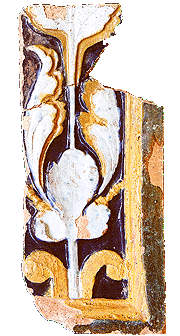
|
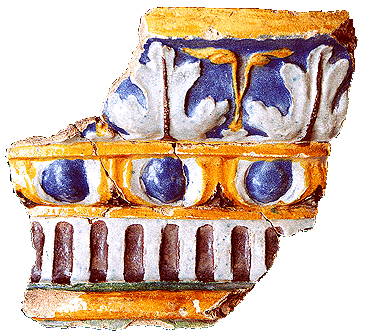
|
|
| Pic. 2 | Pic. 1 |
The oldest tiled Dutch stove dates back to the 16th century. There are many of them all over Europe. The Late Gothic tiled Dutch stove can be seen at the Castle of Hohensalzburg. However, several of them can be found in the Czech Republic, for example, at the Castle of Pernštejn and the Chateau of Vrchlabí. They were built by Renaissance potters in 1545, and are made of ornamented coloured glazed stove tiles.
Very similar tiled Dutch stoves used to be in sitting-rooms in the town of Český Krumlov, for example, in The House of Rožmberks´ rooms, as it is known from written documents. And not only few of them. In 1600 the Rožmberk chronicler Václav Břežan counted 72 stoves at the Český Krumlov Chateau. Most of them were built from green coloured glazed stove tiles called "simple stoves or green stoves", but in nine rooms we would have found "coloured stoves" built from coloured glazed stove tiles. Those ones were placed in the prominent Upper Castle rooms (in Lord of Rožmberk´s living room).
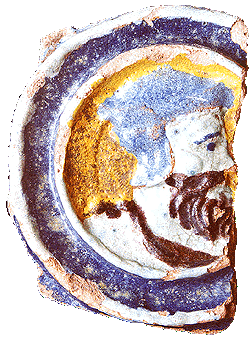
|
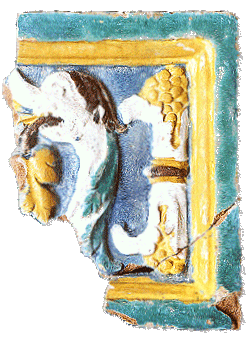
|
|
| Pic. 4 | Pic. 3 |
A large number of bigger and smaller coloured glazed stove tile fragments was found during the II. chateau courtyard archaeological research in 1995 (The archaeological research of the medieval Český Krumlov Castle). Several of them come from the mass finding in 1918 (The Český Krumlov Castle and the collection of the Gothic glazed stove tiles).
There is a wide range of ornaments on the Český Krumlov coloured glazed stove tiles, known from other Renaissance works of art. The mantelpiece tiles are ornamented with cymation, egg and dart - according to their patterns- Roman Ancient temples (picture 1). There are plenty of botanical (picture 2) and allegorical (picture 3) motives on many stove tiles. Less common are figure motives on Renaissance stove tiles. Their spectrum is much more simple than it was in the 15th century- the Gothic style (The Český Krumlov Castle, the collection of the Gothic glazed stove tiles). However, two examples can be found in the Český Krumlov collection. Both of them are the stove tile extensions. Those are lapidary small coloured glazed tablets in different shapes, made of clay, which decorate the stove mantelpiece (picture 4,5). You can see a bearded man´s head in the circle medallion on one of them (picture 4), and probably Father God picture in the oval medallion (picture 5). A very sophisticated lion head relief on other fragment (picture 6).
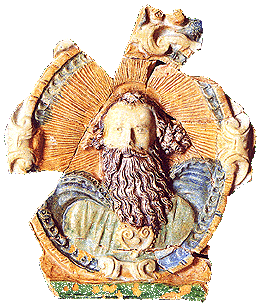
|
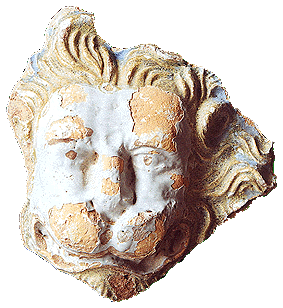
|
|
| Pic. 5 | Pic. 6 |
Coloured glazed tiles have appeared since 1530´s. Besides the traditional green colour you can also see - white, yellow, blue, blue-and-green, brown, black and gold coloured tiles. It was very expensive to produce such tiles due to the costs of needed ingredients to make coloured glazing and the production itself. The potter´s helpers had to gradually impaste all the paint in different colours (often six different colours) to several hundreds of stove tiles needed to build the tiled Dutch stove.
(me)
Further information :
The
archaeological research of the Český Krumlov medieval
Castle
The Český
Krumlov Castle, the collection of the Gothic stove tiles
The
archaeological researches in the town of Český
Krumlov

